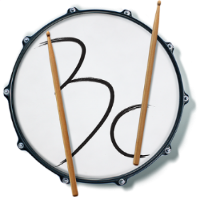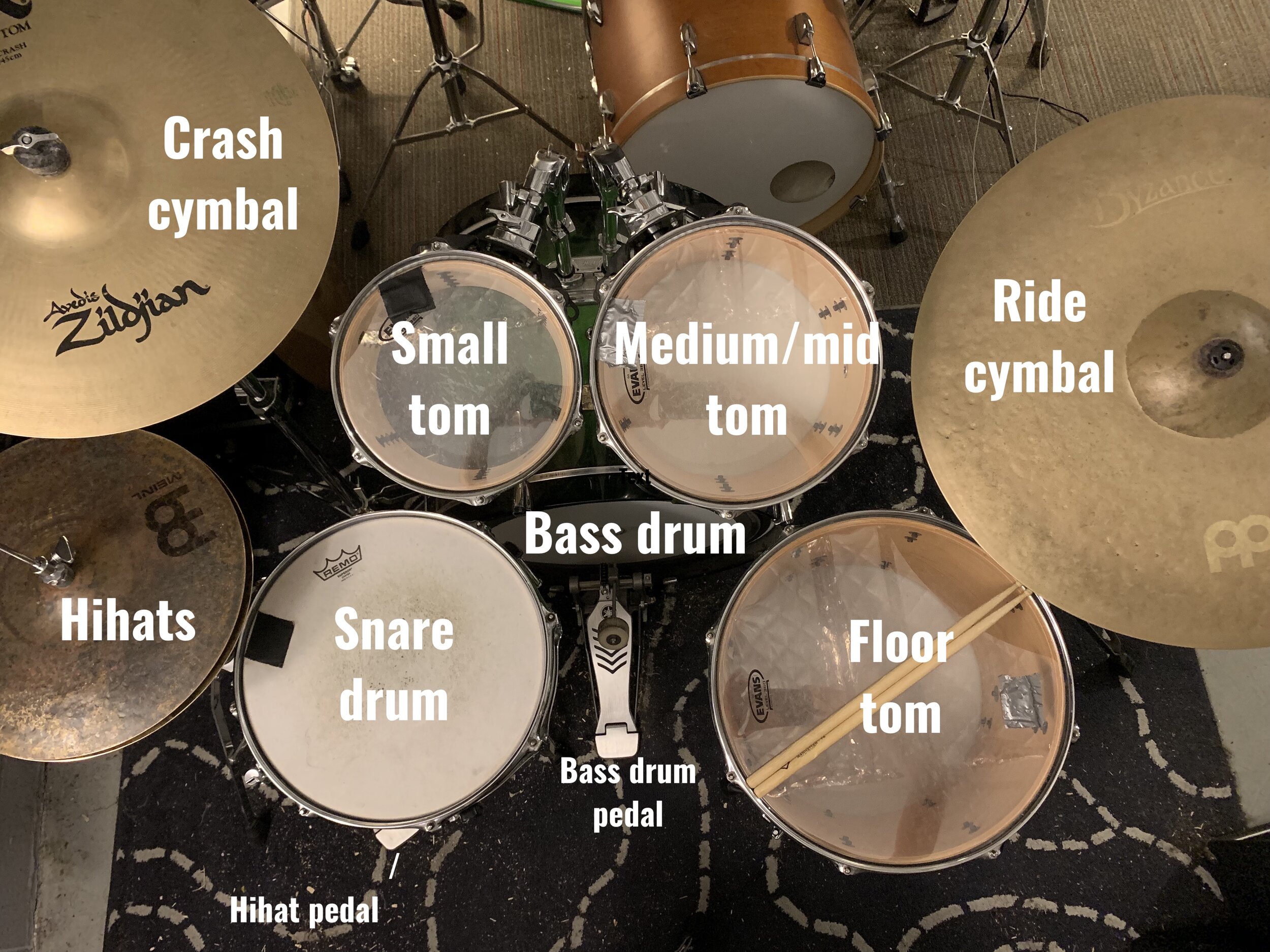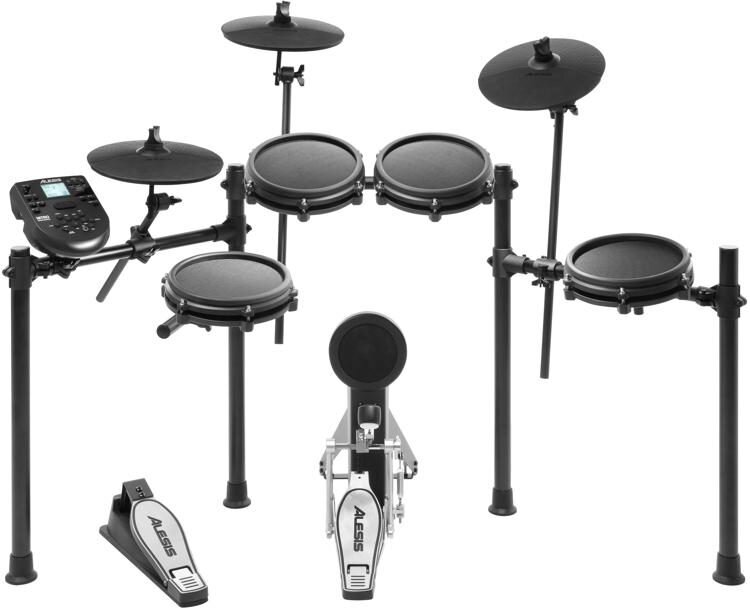The Essentials for Beginner Drummers
When you’re just starting out with the drums (or any new instrument), determining where to begin can be overwhelming. Lots of people just want to hit the ground running so they can begin playing along to their favorite songs or jamming with friends, but there are some basics to cover that will ensure a smooth start to your drumming journey.
The Gear
First and foremost, you’ll need some specific gear in order to start learning drums. Depending on your budget, there are quite a few different options to explore.
1) Drum Sticks
A pair of drum sticks is an absolute must for developing technique as a beginning drummer (obviously). But if you’ve ever stepped into a music store’s drum department, it’s not as simple as grabbing the first pair of sticks you see. There are so many varieties! Sticks come in an array of lengths, thicknesses, tip shapes, tapers, and functions. To start, beginners should try something that’s middle-of-the-road size wise, such as a 5A. If your hands are a little smaller and controlling a stick that size proves a bit challenging, try a smaller model, such as a 7A or an 8D. This blog post takes a much deeper look into the various sizes and types of drum sticks.
2) Practice Pad
Every drummer of any skill level needs to have a practice pad in their arsenal. For beginners especially, most of your early practice sessions should focus on developing good hand technique right out of the gate, which will primarily take place on a practice pad. Pads come in a couple different sizes (most commonly 6” or 12” in diameter), but the playing surface can vary between models and manufacturers. Beginner drummers should pick up a ReelFeel practice pad, which feels and responds similarly to an acoustic snare drum. Some pads have a much softer playing surface, which is good for strengthening the muscles in your hands that are used for playing the drums. Certain models include multiple playing surfaces of different responsiveness, or are dual-purpose with a softer surface on one side, and a much harder surface on the reverse. A couple manufacturers produce a sort of practice pad tree, which allows users to arrange multiple practice pad into the same configuration as an acoustic drum set. They even accommodate a bass drum pedal so drummers can more effectively practice coordination compared to just a single practice pad.
We recommend this practice pad for all our beginning drummers who start lessons with us.
3) Acoustic Drum Set
If you’re looking to get your start on a drum set, you’ll need many more pieces of equipment aside from your sticks and practice pad. At a bare minimum, you’ll want a bass drum (the big one that lays on its side on the floor), snare drum (the one with wires on the bottom that sounds like a whip crack), a pair of hihats (the pair of cymbals that you can play with your foot), and a ride cymbal (a much larger cymbal used to play timekeeping patterns). You could try to piece a kit together through acquiring used drums, but you’ll have a much easier time purchasing a new entry-level drum set. Most entry-level sets include a bass drum, snare drum, one or two rack toms (mounted on or near the bass drum), a floor tom (a larger tomtom that typically has its own legs), and the necessary hardware to mount and position the drums.
Some kits come bundled with cheap cymbals and hardware, too, commonly consisting of a pair of hihats, a ride cymbal, a crash cymbal (often hit sparingly as opposed to being used for timekeeping), and the stands needed to mount them. If you end up happening upon a shell pack (a drum kit that does not include cymbals), you’ll need to purchase cymbals and stands separately.
But that’s not all! No drum set is complete without a bass drum pedal and a proper throne (seat), as well. Bass drum pedals attach to the bass drum (if the name didn’t give it away) and allows you to play the bass drum with one of your feet. Beginners only need a single bass drum pedal, but can eventually upgrade to a double pedal for another area of exploration. You might think you can just use a regular old chair in place or an actual drum throne, but chairs are often too low to effectively play the drums and sometimes even slant back slightly, which facilitates slouching and bad posture when sitting at a drum set. Thrones are flat and allow users to more easily position their feet over the pedals while maintaining good posture.
That’s quite a bit of gear to amass, but that will unlock the ability to practice 4-way coordination, which is necessary for playing grooves and a lot of the “fun stuff.” All of this equipment you can find available for purchase at marketplace websites like Guitar Center, or Sweetwater.
4) Electronic Drum Set
Alesis Nitro drum set with mesh heads - picture from SweetWater
If you don’t have the space for an acoustic drum set (or you just don’t want your neighbors to hate you), then an electronic drum set might be the right move as you’re learning to play the drums. Electronic drum sets have a much smaller footprint than acoustic drums and are MUCH quieter. They are comprised of either rubber pads with sensors inside, or pads with adjustable mesh heads.
Over the past few years, mesh heads have made their way onto many more entry-level electronic drum sets, such as the Alesis Nitro drum set pictured to the right. Generally, mesh heads are even quieter than their rubber counterparts, have a more realistic feel to them, and are more durable. Most electronic drum sets do not include a bass drum pedal or throne, which are still necessary pieces of equipment. Users can plug a pair of headphones directly into the drum computer for near silent practice.
5) Hearing Protection
If you practice on an acoustic drum set, hearing protection is essential. It’s extremely easy to sustain hearing damage while practicing the drums. Once damage occurs, there’s no going back. Ear plugs or isolation headphones (not to be confused with noise-cancelling) will protect your hearing just fine, but you need to use them EVERY TIME you play the drums (or see live music). A solid pair of isolation headphones will also allow you to play along with your favorite music without having to crank the music really loud in order to hear it over the drums. Headphones are also necessary for playing an electronic kit. That way, you can hear the drums through the headphones without needing a separate amplifier.
6) Notebook
It’s important to have a notebook handy in order to keep track of your progress and to jot down any ideas you may encounter as you play and practice. Keeping your practice materials organized will yield better results at a faster pace since you’ll always have something to refer back to later on.
The Concepts
The gear available to you will determine what specifically you should begin practicing. If you’re a total beginner, you should focus more on practicing on a practice pad or snare drum to gain the fundamentals. In some time you can upgrade to a full drumset!
1) Technique
First and foremost, you’ll need to learn to hold the sticks and strike the pad (or drum) properly. It’s not quite as simple as clutching the stick and smashing the pad like you’re trying to hammer a nail. Proper technique will ultimately allow you to play with more control at a wide range of speeds and volumes while exerting little effort. It’s something that develops over a long period of time so it’s best to start off with good habits.
2) Basic Sticking Patterns
Playing through simple patterns is an excellent way to begin practicing technique and basic coordination. The most basic pattern, known as single strokes, consists of alternating your hands as you play (right, left, right, left, etc). The sticking is typically shortened to RLRL, where R represents the right hand, and L represents the left. That one pattern is the most fundamental building block to playing the drums. Another one of the most important and basic sticking patterns is known as double strokes. As the name implies, it involves playing two strokes consecutively with one hand before switching to the next (right, right, left, left, etc). Perform each pattern slowly at first, ensuring that the strokes are even in both spacing and volume. Practicing drumming along to some music will help you develop a more solid sense of time while keeping practice fun and engaging.
Next, combine single strokes and double strokes together into one pattern. Coupling a pair of single strokes with a set of double strokes creates a new pattern, known as single paradiddles. The sticking for single paradiddles is as follows: RLRR LRLL. Single strokes, double strokes, and single paradiddles are all examples of rudiments, which are short patterns that are used to develop greater control over the sticks and creative expression on the drums. There are a total of 40 Essential Rudiments, but beginners should focus primarily on the three mentioned here.
3) Rhythms and Basic Reading
Those sticking patterns are pretty useless without applying them to defined rhythms. In addition to developing your technique, it’s also important to understand some music theory concepts. Learning a bit of theory will give you some universal terms you can use to communicate about music with other musicians.
Quarter notes, 8th notes, 16th notes, and triplets. One measure of each.
Practically all music is built upon a steady underlying pulse. This pulse can be split into smaller parts, known as subdivisions. There are typically 4 pulses, or beats, in each cycle. Each cycle is known as a measure. If you played a stroke directly on each underlying beat, you’d be playing quarter notes. If you played two evenly spaced strokes per beat, you’d be playing 8th notes (there are 8 8th notes in one measure of 4 beats). Splitting 8th notes into two parts a piece results in 16th notes. It’s also possible to split beats in 3 equal parts, known as triplets. Most music is composed using combinations of quarter notes, 8th notes, 16th notes, and triplets. There are larger beat values, such as half notes (2 full beats) and whole notes (4 full beats), but those are typically played by instruments that can sustain a note.
The interface of the Pro Metronome app
If you begin your drumming journey by taking drum lessons (which is a REALLY good idea so you don’t accidentally develop any bad habits), your instructor will teach you more about beat values, rhythms, and how to read music. While knowing how to read music isn’t necessarily a make-or-break deal for hobbyist drummers, it definitely provides a deeper understanding of music as a whole, and will allow your teacher to give you tangible practice materials you can refer to later. Understanding some music theory and knowing how to read music also serves as a valuable tool for expanding upon an idea or concept.
4) Timekeeping
As drummers, it’s extremely important to develop a solid sense of time (obviously). There are a few different tools to use and ways to practice time. Using a metronome is an excellent way to begin internalizing steady beats, but an even better way to “find” the time is by playing along with music. Almost all modern music is recorded with a click track (a preprogrammed metronome that follows the form of a song) so practicing along with music carries many of the same benefits as just practicing with a metronome. Playing along with music will also help you pick up on some of the more subtle inflections that are used for shaping rhythms. Developing a better sense of time takes a lot of time (no way to avoid that pun) and directly relates to how you move when you play. The more relaxed you are, the easier it’ll be to play steady time.
5) Coordination and Basic Beats
If you have access to a drum set, you can also begin practicing coordination between your hands and your feet. Playing any type of groove typically requires 3 or even all 4 of your limbs to function simultaneously.
A handy chart for reading drum set sheet music by Steve Snodgrass.
To begin getting your hands and feet talking to each other, start playing steady single strokes with your hands at an 8th note rate (two strokes per beat). With your feet, step on the bass drum and hihat pedals once per beat (a quarter note rate). Operating all 4 limbs at once is quite tricky so start as slowly as you need to in order to play everything accurately.
As you get more comfortable moving all 4 limbs at the same time, begin exploring some basic feels, such as a rock groove or a swing pattern. To play a basic rock groove, start with 8th notes on the hihats. Play the bass drum on beats 1 and 3 (known as downbeats), and hit the snare drum on beats 2 and 4 (known as backbeats). This basic groove is the foundation to literally thousands of different songs and can work in various styles of music.
If jazz is more your style, then it’s best to learn a swing pattern as soon as possible. While rock beats use a steady 8th note feel, jazz music often uses a swing feel, which is built on a triplet rate instead of 8th notes. A typical swing pattern is played between the ride cymbal and hihat pedal. On the ride cymbal, begin by playing quarter notes. To really make it “swing,“ play another stroke on the last triplet space of beats 2 and 4. Those additional strokes lead into the following beats, giving the groove forward momentum. And finally, with your hihat pedal, step down on beats 2 and 4, creating a nice “chick” sound. This swing pattern is the foundation for jazz drumming and is something that every drummer should learn to play early on in their development.
A basic rock beat and a basic swing pattern.
Beginning to learn the drums can be overwhelming at first, but as long as you start simple with the necessary gear and focus on the basics, you’ll develop a sturdy foundation to build upon. The hardest part is knowing where exactly to begin!
A good place to start if you’re a complete beginner drummer is with our free 7-day course. The course covers the fundamentals of technique, basic patterns, some music theory, and how to practice each of the demonstrated exercises. And what’s better than free stuff?









